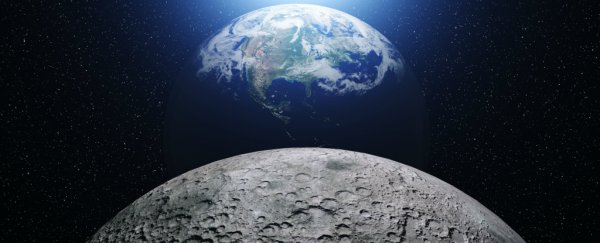A lunar meteorite, discovered in the desert of northwest Africa, holds strong evidence that there is an abundant supply of water on the Moon - maybe even enough for a future colony.
Examining the meteorite, scientists from Tohoku University have determined that the other-worldly rock is made up of moganite, a mineral that requires water in order to form.
The discovery marks the very first time that scientists have ever detected this mineral in a lunar rock.
"Moganite is a crystal of silicon dioxide and is similar to quartz. It forms on Earth as a precipitate when alkaline water including SiO2 is evaporated under high pressure conditions," said lead researcher Masahiro Kayama.
"The existence of moganite strongly implies that there is water activity on the Moon."
For a long time, scientists thought that the Moon was completely devoid of water, and while that may be true on the surface, several studies suggest there is abundant water, in the form of ice, lurking somewhere under that dry lunar crust.
Nevertheless, there is still a lot of debate on where all of this hydration is supposedly located. Some studies suggest that the Moon's water is clustered around the poles. Other, more recent studies suggest it is far more widely distributed.
Now, the moganite meteorite provides the very first evidence that there is ice at mid and lower latitudes on the Moon.
Using electron microscopy, the team of researchers analyzed the chemical compositions of 13 lunar meteorites, all of which were found in the northwest desert of Africa. Then, using micro-Raman spectroscopy, specific mineral structures within each lunar object were identified.
Moganite was discovered in just one of the samples, which means that the mineral could not have formed after the lunar rock made its way to Earth.
"If terrestrial weathering had produced moganite in the lunar meteorite, there should be moganite present in all the samples that fell to Earth around the same time. But this was not the case," explained Kayama.
Instead, the researchers think that the mineral was formed through evaporated water on the surface of the Moon in a region called Procellarum Terrane, which receives strong, direct sunlight.
If the theory is proved correct, it means that there could be water hidden in the subsurface of this region, where it is protected from sunlight and evaporation.
"For the first time, we can prove that there is water ice in the lunar material," Kayama told Space.com.
"In a moganite, there is less water, because moganite forms from the evaporation of water. That's the case on the surface of the moon. But in the subsurface, much water remains as ice, because it's protected from the sunlight."
 (M Sasaoka/SASAMI-GEO-SCIENCE)
(M Sasaoka/SASAMI-GEO-SCIENCE)
The researchers have estimated that the water in the lunar soil is about 0.6 weight percent, which, according to Kayama, would be enough for future lunar explorers to extract about 6 litres per cubic metre of lunar rock (1.6 gallons of water per 36 cubic feet).
If the estimate is correct, that means there would be ample water for future Moon colonies.
The problem is, the study cannot be confirmed using existing lunar samples, which means that the theory will remain just that until we can return to the Moon for more.
Luckily, there are a few missions in the works. Japan's Aerospace Exploration Agency has announced two lunar expeditions that will explore for water sources and bring back more samples from the far-side of the Moon.
In the meantime, Kayama and his team are focused on examining water that is formed from solar wind and volcanoes - two ways that water could have formed on the Moon.
"Solar wind-induced water can give us new insight into the history of Sun activity, and volcanic water provides us with information of lunar evolution together with water," said Kayama.
"It's all very exciting."
The study has been published in Science.
